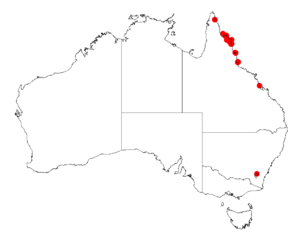Acacia racospermoides facts for kids
Quick facts for kids Acacia racospermoides |
|
|---|---|
| Scientific classification | |
| Genus: |
Acacia
|
| Species: |
racospermoides
|
 |
|
| Occurrence data from AVH | |
Acacia racospermoides is a type of shrub or small tree. It belongs to the Acacia family, also known as wattles. This plant is special because it only grows in a certain part of north-western Australia. It is found nowhere else in the world.
What It Looks Like
This shrub or tree usually grows to be about 2 to 6 meters (6 to 20 feet) tall. It often has a thin or slender shape. Its bark is white and smooth. The bark is also covered in a fine white powdery coating.
Like most Acacia plants, it does not have true leaves. Instead, it has what are called phyllodes. These are flattened leaf stalks that look and act like leaves. The phyllodes are thin and leathery. They stay green all year round. They are shaped like a narrow oval, sometimes slightly curved like a sickle. Each phyllode is about 5 to 15 centimeters (2 to 6 inches) long. They are also about 1 to 2.5 centimeters (0.4 to 1 inch) wide. You can see three main lines, or nerves, running along them.
Where It Grows
Acacia racospermoides is found along the coast in north-eastern Queensland, Australia. It grows in different spots from Bathurst Bay in the north down to Cooktown in the south. You can also find other groups of these plants near Cairns and on Hinchinbrook Island.
This plant prefers to grow in sandy soils. It is often found in open forests and areas with heathland plants.
How It Got Its Name
The plant was officially named Acacia racospermoides by a botanist named Leslie Pedley. He described it in 1990. This information was published in a science journal called Austrobaileya.
Before 1990, Leslie Pedley had first described this plant in 1987. At that time, he called it Racosperma paniculatum. Later, it was moved into the Acacia group of plants.

